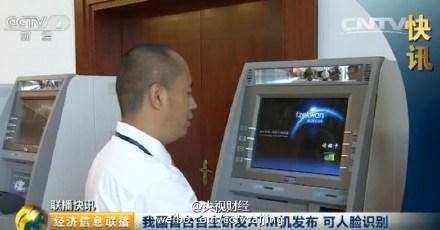The world's first ATM designed to use facial recognition technology has been released in China. A collaborative effort between Tsinghua University and Hangzhou-based technology company Tzekwan, this is China's first such ATM independently developed for mass public use. The new ATM integrates many new technologies, as well as improvements on current capabilities.
 |
-- Photo provided by Weibo.com
Created with the goal of “cracking down on financial crimes,” abilities of the new ATM include matching users facial images with their government identification. The ATM will be linked to banks and law enforcement agencies to reduce fraud risks. Only the proven account holder will be able to extract funds after facial verification, so they will not be able to give a credit card to a family member for use, for example. Developers claim the machine is able to recognize biological changes to the user, so changes in weight, hair and age will not confuse the system.
The technology will also help solve many currency issues, including recording serial numbers from currency notes in order to detect fake bills. The ability to scan and analyze multiple currencies for counterfeiting has been improved 20% over current systems. The overall transaction and computing speed have also significantly increased.
Facial recognition technology has become more common worldwide in recent years. Governments use it in street cameras throughout Europe. In the United States, facial recognition cameras are also quite common. Walmart is beginning installation of facial recognition cameras in newly-constructed stores. Washington's Dulles airport is testing new cameras in their customs department. Local law enforcement, retail stores and even bars have been adding the new tracking systems to their security programs for years.
Japan is also a major center for facial tracking software for things like targeted advertising on billboards. A billboard can tell what ad to show based on the facial scan of a passerby. Japanese vending machines offer foods and drinks based on gender and age stereotyping. Restaurants and hotels also use cameras to identify VIPs for improved service initiatives upon arrival.
